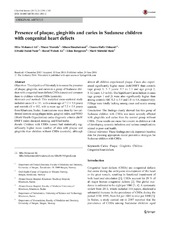| dc.contributor.author | Mohamed Ali, Hiba | en_US |
| dc.contributor.author | Mustafa, Manal | en_US |
| dc.contributor.author | Hasabalrasol, Siham | en_US |
| dc.contributor.author | Elshazali, Osama Hafiz | en_US |
| dc.contributor.author | Nasir, Elwalid Fadul | en_US |
| dc.contributor.author | Ali, Raouf Wahab | en_US |
| dc.contributor.author | Berggreen, Ellen | en_US |
| dc.contributor.author | Skeie, Marit Slåttelid | en_US |
| dc.date.accessioned | 2017-06-01T11:09:04Z | |
| dc.date.available | 2017-06-01T11:09:04Z | |
| dc.date.issued | 2017-05 | |
| dc.Published | Mohamed Ali HM, Mustafa M, Hasabalrasol, Elshazali, Nasir EF, Ali RW, Berggreen E, Skeie MS. Presence of plaque, gingivitis and caries in Sudanese children with congenital heart defects. Clinical Oral Investigations. 2017;21:1299-1307 | eng |
| dc.identifier.issn | 1432-6981 | |
| dc.identifier.uri | https://hdl.handle.net/1956/15918 | |
| dc.description.abstract | Objectives: The objective of this study is to assess the presence of plaque, gingivitis, and caries in a group of Sudanese children with congenital heart defects CHDs (cases) and compare them to children without CHDs (controls). Materials and methods: This analytical cross-sectional study included cases (N = 111, with a mean age of 7.2 ± 3.0 years) and controls (N = 182, with a mean age of 7.2 ± 2.8 years) from Khartoum, Sudan. Examinations were done by two calibrated dentists using plaque index, gingival index, and WHO (World Health Organization) caries diagnostic criteria (dmft/DMFT index: decayed, missing, and filled teeth). Results: Children with CHDs (cases) had statistically significantly higher mean number of sites with plaque and gingivitis than children without CHDs (controls), although almost all children experienced plaque. Cases also experienced significantly higher mean dmft/DMFT than controls (age group 1, 3–7 years: 3.7 vs 2.3 and age group 2, 8–12 years: 1.3 vs 0.6). The Significant Caries Indices in cases (age groups 1 and 2) were also significantly higher than among controls (SiC 8.2 vs 5.9 and 1.8 vs 0.8, respectively). Fillings were totally lacking among cases and scarce among controls. Conclusions: The findings clearly showed that this group of Sudanese children with CHDs was more severely affected with gingivitis and caries than the control group without CHDs. These results are cause for concern in children at risk of developing systemic infections and serious complications related to poor oral health. Clinical relevance: These findings provide important baseline data for planning appropriate dental preventive strategies for Sudanese children with CHDs. | en_US |
| dc.language.iso | eng | eng |
| dc.publisher | Springer | eng |
| dc.rights | Attribution CC BY | eng |
| dc.rights.uri | http://creativecommons.org/licenses/by/4.0 | eng |
| dc.subject | Caries | eng |
| dc.subject | Plaque | eng |
| dc.subject | Gingivitis | eng |
| dc.subject | Children | eng |
| dc.subject | Congenital heart defects | eng |
| dc.title | Presence of plaque, gingivitis and caries in Sudanese children with congenital heart defects | en_US |
| dc.type | Peer reviewed | |
| dc.type | Journal article | |
| dc.date.updated | 2017-05-09T07:36:18Z | |
| dc.description.version | publishedVersion | en_US |
| dc.rights.holder | Copyright 2016 The Author(s) | |
| dc.identifier.doi | https://doi.org/10.1007/s00784-016-1884-2 | |
| dc.identifier.cristin | 1408702 | |
| dc.source.journal | Clinical Oral Investigations | |

